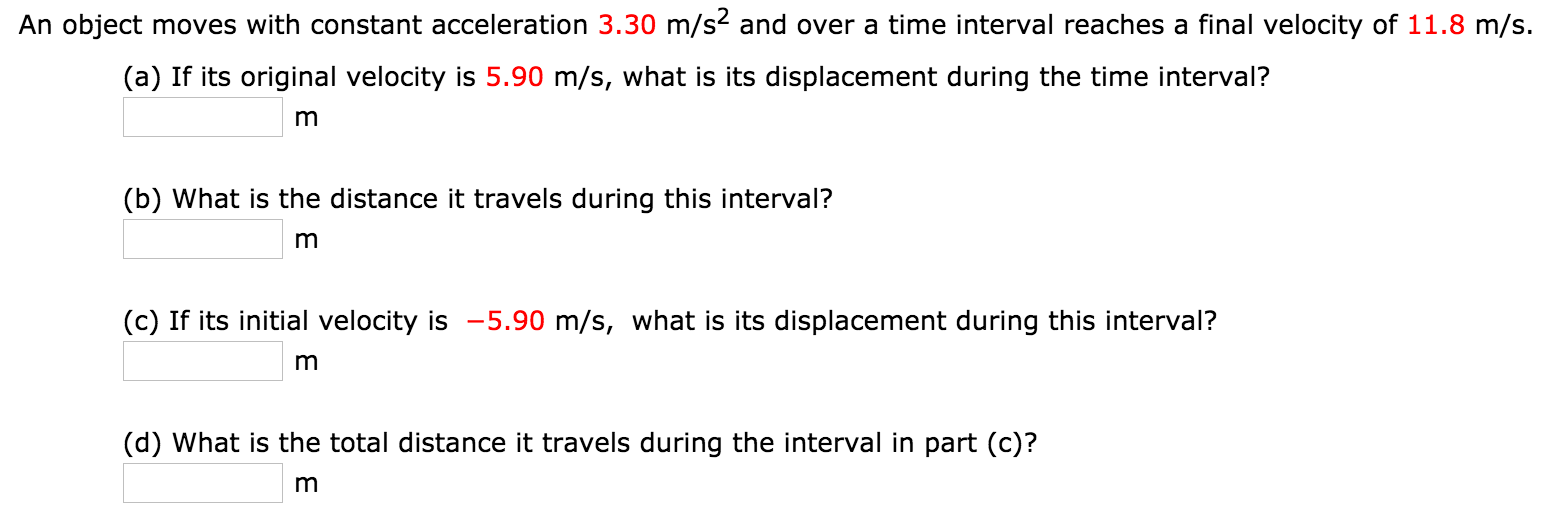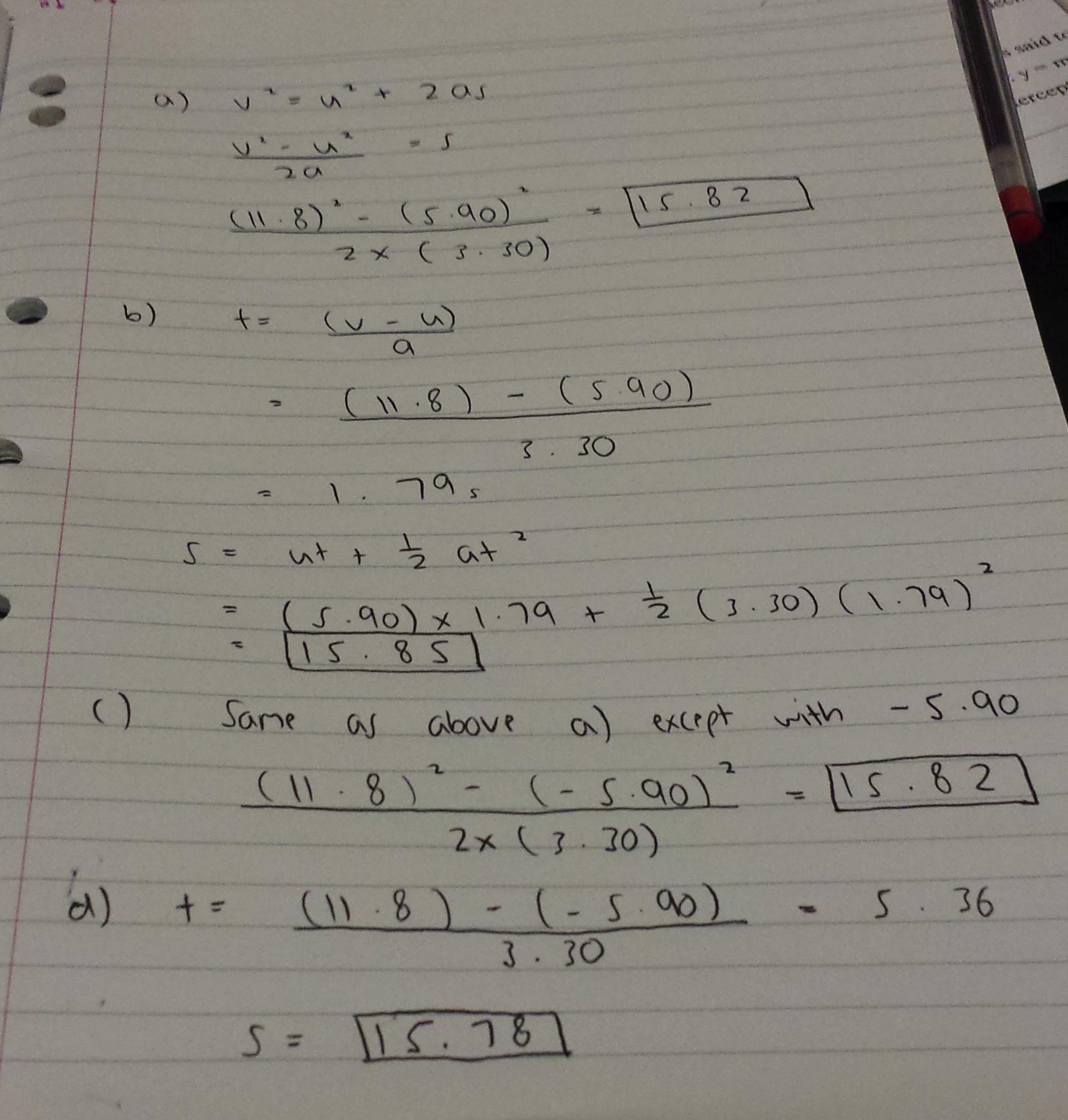The formula is going to work for any units, it's just that your final answer will have units based on what units you used. Like if you did the distances in km and the time in s, the answer would be expressed in km/s.Ohhh it seems I confused myself...... nevermind lol.
But if say a question had km instead of m and asked to find the average velocity, do I have to change km to m before plugging the numbers into the formula?
Make a Difference – Donate to Bored of Studies!
Students helping students, join us in improving Bored of Studies by donating and supporting future students!
Physics Help Thread (1 Viewer)
- Thread starter BlueGas
- Start date
Green Yoda
Hi Φ
- Joined
- Mar 28, 2015
- Messages
- 2,857
- Gender
- Male
- HSC
- 2017
first is basically v=u+at where v=final velocity, u or v(0) in your case = initial velocity and t= timeWhat do these formulas mean? I know it's relating constant acceleration but why are there 3 different formulas?

second one the formulas is basically r=ut+0.5at^2 where r or x in your case is the displacement, u or v(0) = initial velocity, a=acceleration and t=time
third one its basically v^2=u+2ar where v=final velocity, u or v(0)= initial velocity, r or x = displacement and a=accleration
The first tells us the velocity at time t if you know the answer initial velocity (i.e. at t = 0) and the value of the constant acceleration. It lets us answer Q's like "A car is accelerating at a constant rate of 4 m/s^2. If it started at a speed of 1 m/s, how fast is it going after 10 seconds?"What do these formulas mean? I know it's relating constant acceleration but why are there 3 different formulas?

The second tells us what the particle's displacement is at time t relative to its starting point if we know its initial velocity and the value of the constant acceleration. E.g. If a ball is dropped, what distance has it fallen after 4 s? If a car is accelerating at a constant rate of 5 m/s^2, and started at a speed of 20 m/s, how far has it travelled after 10 seconds? We can answer Q's like this with this formula.
The third one is a useful formula relating the velocity to the displacement, if we know the initial velocity and the constant acceleration. It lets us answer Q's like "A car is accelerating from rest at a constant rate of 8 m/s^2. How fast is it going after it has travelled 100 m?" Or "A ball is dropped from a 100 m building. How fast is it travelling just before it hits the ground?" or "A car was travelling at a speed of 60 km/h. It needs to come to a halt in 50 m. What is the average deceleration required to do so?"
So there's different formulas because they tell us how to calculate different things or based on different given data (e.g. based on whether we're given displacement or time, one of formula 1 or 3 would be appropriate to find the velocity, etc.)
Green Yoda
Hi Φ
- Joined
- Mar 28, 2015
- Messages
- 2,857
- Gender
- Male
- HSC
- 2017
The different formulas are used in exam depending on info given and what we have to find..they can also be rearranged
Green Yoda
Hi Φ
- Joined
- Mar 28, 2015
- Messages
- 2,857
- Gender
- Male
- HSC
- 2017
v is not velocity (average) it is final velocityv is velocity, a is acceleration, t is time taken, s is displacement, am I right? What does u mean?

u is initial velocity
Green Yoda
Hi Φ
- Joined
- Mar 28, 2015
- Messages
- 2,857
- Gender
- Male
- HSC
- 2017
Don't get confused by v which can be average velocity, e.g p=mv but v can also be final velocity, e.g v=u+at
BlueGas
Well-Known Member
- Joined
- Sep 20, 2014
- Messages
- 2,439
- Gender
- Male
- HSC
- N/A
Ahh ok so acceleration-wise v is final velocity, thanks!!Don't get confused by v which can be average velocity, e.g p=mv but v can also be final velocity, e.g v=u+at
Green Yoda
Hi Φ
- Joined
- Mar 28, 2015
- Messages
- 2,857
- Gender
- Male
- HSC
- 2017
Yes velocity by it self is average velocity is given by total displacement/time intervalAhh ok so acceleration-wise v is final velocity, thanks!!
but the change in velocity or acceleration is (v-u)/t which is where v=u+at is derived from.
For d), your answer is less than your answer for c) – how can this be possible? The total distance it travels would have to be at least whatever its change in displacement is over that time interval.Guys are my answers correct?
a) 15.82
b) 15.85
c) 15.82
d) 15.78

BlueGas
Well-Known Member
- Joined
- Sep 20, 2014
- Messages
- 2,439
- Gender
- Male
- HSC
- N/A
Ah I need to review my answers...For d), your answer is less than your answer for c) – how can this be possible? The total distance it travels would have to be at least whatever its change in displacement is over that time interval.
BlueGas
Well-Known Member
- Joined
- Sep 20, 2014
- Messages
- 2,439
- Gender
- Male
- HSC
- N/A
Okay so this is my working out (I got the same answers...)For d), your answer is less than your answer for c) – how can this be possible? The total distance it travels would have to be at least whatever its change in displacement is over that time interval.

Green Yoda
Hi Φ
- Joined
- Mar 28, 2015
- Messages
- 2,857
- Gender
- Male
- HSC
- 2017
a)
a=(v-u)/t
t=(v-u)/a
t=(11.8-5.9)/3.3
t=1.79s
r=ut+0.5at^2
r=(5.9*1.79)+0.5(3.3*1.79^2)
r=15.85m positive direction
a=(v-u)/t
t=(v-u)/a
t=(11.8-5.9)/3.3
t=1.79s
r=ut+0.5at^2
r=(5.9*1.79)+0.5(3.3*1.79^2)
r=15.85m positive direction
BlueGas
Well-Known Member
- Joined
- Sep 20, 2014
- Messages
- 2,439
- Gender
- Male
- HSC
- N/A
I'm having trouble understanding equivalent resistance and equivalent capacitance.
Why is it that when calculating the equivalent capacitance of a parallel circuit it is the sum of the reciprocals of the individual resistances, but then the equivalent resistance of a parallel circuit is the sum of the individuals resistances? Why is it different?
Why is it that when calculating the equivalent capacitance of a parallel circuit it is the sum of the reciprocals of the individual resistances, but then the equivalent resistance of a parallel circuit is the sum of the individuals resistances? Why is it different?
